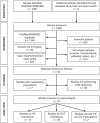Venous thromboembolism in COVID-19: A systematic review and meta-analysis
- PMID: 33818197
- PMCID: PMC8024143
- DOI: 10.1177/1358863X21995566
Venous thromboembolism in COVID-19: A systematic review and meta-analysis
Abstract
Severe coronavirus disease 2019 (COVID-19) is associated with increased risk of venous thromboembolism events (VTE). This study performed a systematic review in PubMed/EMBASE of studies reporting the prevalence of VTE in patients with COVID-19 who were totally screened/assessed for deep vein thrombosis (DVT) and/or for pulmonary embolism (PE). Among 47 candidate studies (n = 6459; 33 in Europe), 17 studies (n = 3973; weighted age 63.0 years, males 60%, intensive care unit (ICU) 16%) reported the prevalence of PE with a pooled estimate of 32% (95% CI: 25, 40%), and 32 studies (n = 2552; weighted age 62.6 years, males 57%, ICU 49%) reported the prevalence of DVT with a pooled estimate of 27% (95% CI: 21, 34%). A total of 36 studies reported the use of at least prophylactic antithrombotic treatment in the majority of their patients. Meta-regression analysis showed that the prevalence of VTE was higher across studies with a higher percentage of ICU patients and higher study population mean D-dimer values, and lower in studies with mixed dosing of anticoagulation in ⩾ 50% of the population compared to studies with standard prophylactic dosing of anticoagulation in < 50% of the population. The pooled odds ratio for death in patients with COVID-19 and VTE versus those without VTE (17 studies, n = 2882) was 2.1 (95% CI: 1.2, 3.6). Hospitalized patients with severe COVID-19 are at high VTE risk despite prophylactic anticoagulation. Further research should investigate the individualized VTE risk of patients with COVID-19 and the optimal preventive antithrombotic therapy. PROSPERO Registration No.: CRD42020185543.
Keywords: SARS-CoV-2; deep vein thrombosis (DVT); prevalence; pulmonary embolism (PE).
Conflict of interest statement
Figures




Comment in
-
PERTinent new insights into venous thromboembolism risk and management in hospitalized patients with COVID-19.Vasc Med. 2021 Aug;26(4):434-436. doi: 10.1177/1358863X211012776. Epub 2021 May 20. Vasc Med. 2021. PMID: 34014133 No abstract available.
References
Publication types
MeSH terms
LinkOut - more resources
Full Text Sources
Other Literature Sources
Medical
Miscellaneous

